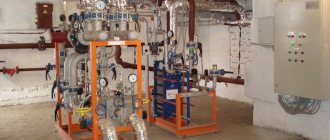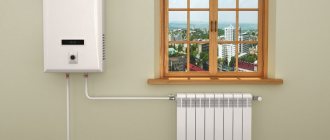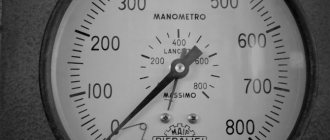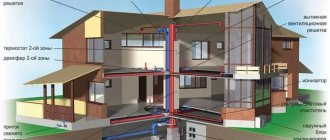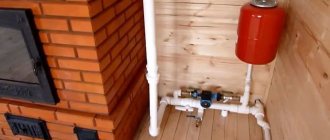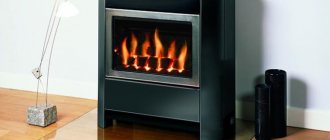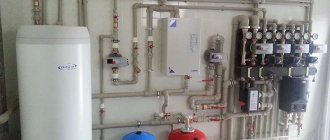Your own home is not only a personal fortress, but also a place where it is cozy and warm. For this to always be the case, a prudent owner must provide an uninterrupted supply of heat. The easiest way to do this is if you can connect to a centralized system.
However, this is not always the case, and many do not want to connect to an expensive service. In this case, it remains to consider the types of heating systems suitable for autonomous installation, and then choose the best option. And we will try to help you in this matter - our article discusses the features of water, air and infrared heating systems, listing their main pros and cons.
We have also provided useful recommendations for choosing the best option. The presented material was provided with visual diagrams, photographs and videos with reviews of these heating systems.
Alternative heat sources
Today, a great variety of different types of appliances are used, thanks to which economical heating of a private, country or country house is achieved.
- solar panels;
- heat pumps;
- geothermal heat sources.
The sun will always be eternal, and, most importantly, an absolutely free source of energy. Its use for heating homes has been used since ancient times. Modern solar panels effectively heat rooms and save money spent on heating homes.
Solar panels are increasingly found in private homes.
Heat pumps are becoming increasingly popular; their use helps heat rooms in all weather conditions. Geothermal heat sources are also widely used in some regions rich in this type of thermal energy.
It is worth noting that the use of such heat sources is becoming more and more economically feasible compared to traditional equipment running on gas or solid fuel.
It should be noted that such modern units are quite expensive, their purchase and installation will cost a little more, but this price of an alternative source of thermal energy will be recouped within several years.
Summary
There are various economical heating systems aimed at maintaining the required temperature without compromising the level of comfort of a country house.
It has been proven that the installation of additional equipment or energy-saving devices significantly simplifies and automates the processes of maintaining and regulating comfortable temperature conditions. The use of such devices and units is not only convenient, but also profitable.
Use of thermal accumulators
As is known, in many utility organizations, electricity tariffs at night differ significantly downwards compared to daytime electricity supply. Therefore, in order to coordinate the process of heating a residential building throughout the whole day, you can use a device called a thermal accumulator, which is a capacious tank equipped with thermal insulation. It’s not at all difficult to make a heat accumulator with your own hands.
Thus, using a heat accumulator, you can configure the system so that the water in the heating circuit will be heated exclusively at night, when electricity charges are lower, and during the day the coolant will be gradually transferred to the radiators.
Installing it in conjunction with a heating boiler operating on solid raw materials will help improve the performance properties of a heat accumulator for heating. The power of such equipment is quite enough to accumulate heat with just one load of fuel per day.
Latest heating systems
An example of a fairly affordable and at the same time effective system, suitable for both a country house and an apartment, is an electric heated floor. By incurring relatively small expenses for the installation of such heating, you can provide your home with heat and not buy any boilers. There is only one drawback - the cost of electricity. But considering that modern underfloor heating is quite economical, and if you have a multi-tariff meter, this option may be acceptable.
In southern regions with high solar activity, another modern heating system performs well. These are water-based solar collectors installed on the roof of buildings or other open areas. In them, with minimal losses, water is heated directly from the sun, after which it is supplied to the house. One problem is that collectors are absolutely useless at night, as well as in the northern regions.
Various solar systems that take heat from the ground, water and air and transfer it to a private home are installations that implement the most modern heating technologies. Consuming only 3-5 kW of electricity, these units are capable of “pumping” 5-10 times more heat from outside, hence the name – heat pumps. Then, using this thermal energy, you can heat the coolant or air, at your discretion.
How to choose the best heating system?
There are many heating systems. They all have attractive sides and significant disadvantages. It is quite difficult for an unprepared person to navigate them and make the right choice. In order not to make mistakes, you need to know exactly what points you should pay attention to.
Firstly, it is the availability of fuel and its cost. This can be considered a key point. No matter how much you like the system, if the fuel for it is difficult to obtain, is supplied to the region intermittently, or is too expensive, you should consider another option. Otherwise, heating your home will cost a pretty penny and will be ineffective.
According to statistics, most owners of private houses choose heating systems with liquid coolant. This is a practical, reliable and quite economical option
The second point is the possibility of combining heating systems. In some cases, it may be very practical to use a primary and secondary system. This gives confidence that in the event of possible interruptions in energy supplies, the house will not be left without heat.
In addition, there is an opportunity to save money, since you can use the most economical heating method at the moment.
And finally, the financial side of the issue. It is necessary to determine how much the consumer can allocate for the purchase of equipment, its proper installation and subsequent regular maintenance.
Geothermal installation
Its operating principle is similar to the hydrothermal option. The difference is that the heat of the earth is used, not water.
Equipment Features
Laying the outer contour can be done both vertically and horizontally. The vertical arrangement is due to a number of difficulties during the installation process. For pipes it is necessary to drill wells to great depths. But there are two negative aspects associated with horizontal laying:
- a large area of private land is required to accommodate the circuit;
- it is impossible to plant plants because the collector will cool their roots.
In both cases, heat is taken directly from the soil near a private building. The geothermal pump responsible for pumping the coolant is located in the house itself. The shaft with the heat exchanger should be located in close proximity to the building.
Advantages of using earth's heat
This system has the following advantages:
- The thermal energy of the earth is an inexhaustible source of energy;
- autonomous operation of the system;
- absolute fire safety, no risk of fire;
- minimal energy consumption;
- there is no need for fuel delivery and storage;
- long service life.
The high cost of the object is the main disadvantage. A geothermal installation for the same square footage as in the previous case will increase to 600 thousand rubles.
Basic heating options for a cottage 2. Gas holder
If there is no main gas, you can store liquefied gas. Many do this, although this method assumes that you will have a huge container of explosive liquefied gas constantly buried on your site. At a minimum, this requires a fairly large fenced area where nothing can be planted or built, and special security measures. In addition, an accessible source of liquefied gas is required with the possibility of delivery to the site.
The cost and efficiency of boilers for liquefied gas are approximately the same as for main gas. Installing a gas tank will cost about 400,000 rubles. In terms of 50 years, we get 800,000 rubles, or 16,000 rubles. in year.
If the cost of liquefied gas is 15 rubles per liter (with delivery within 100 km from a large city) and the specific heat of combustion of the propane-butane mixture is about 12.8 kW*h/l, we get the cost of 1 kW*h of heat at 1.23 rubles, which is equivalent to costs of 104,550 rubles. in year.
And taking into account the cost of operation - 120,550 rubles. in year.
Solar panels
Using solar energy for heating is the most inexpensive and accessible way. The main task is to convert sunlight into heat with minimal losses.
System design
The main element of such a system is the solar collector. This is a device consisting of tubes that lead to a coolant reservoir. There are vacuum, air and flat collectors. In addition to them, the composition includes the following units:
- heat exchanger;
- storage tank;
- pipeline;
- front camera.
A storage tank is a container with heated coolant. From the top of the container, liquid is supplied to the heating devices. After passing through the entire heating circuit, the cooled coolant again enters the tank.
The anterior chamber serves to prevent air retention in the heating pipeline. It is a tank that is located at the highest point of the system. Collectors must be installed at an angle of 35–40°. This slope will ensure maximum efficiency. To minimize heat losses, all pipelines leading from the collector to the heat exchanger must be insulated.
Advantages and disadvantages
It is worth noting the main advantages of a solar battery:
- high efficiency;
- long service life - more than 25 years;
- ease of maintenance;
- independence from low air temperatures.
But it is still better to use batteries as an additional source of heat for private homes. In winter, the sun's energy will not be enough to accumulate the required amount of heat. During periods of increased cloudiness, your home may also remain cold. New technologies make it possible to combine several types of heating into one complex, and solar panels can be combined with a geothermal installation or infrared radiation.
Disadvantages also include very high prices for solar collectors and equipment. To heat a 100 m² house, installing solar panels will cost approximately 900,000 rubles.
Basic heating options for a cottage 4. Solid fuel
Firewood, pellets (briquettes) or coal can be used in this capacity. However, you need to understand that a solid fuel boiler is not fully automatic. This means that someone must always work as a fireman. In the case of pellet boilers, the level of automation is higher, but the level of danger of fuel fire is also higher.
This must also be taken into account when using coal boilers. Therefore, in both cases additional security measures will be required. The cost of equipment varies greatly. For example, a 15-kilowatt boiler with manual loading will cost about 25,000 rubles, but you are unlikely to enjoy the prospect of constantly running to the boiler room and adding firewood or coal by hand. A boiler with automatic fuel supply can cost from 100,000 (pellet) to 200,000 rubles. (carbonic). True, they all serve for 20–25 years.
As a result, operating a wood-burning boiler will cost 6,250 rubles. per year, automatic pellet - 10,000, and automatic coal - 15,000 (all taking into account the cost of annual maintenance).
The cost of fuel depends significantly on the region. For example, in the Moscow region, 1 cubic meter (on average 650 kg) of birch firewood at a wholesale price today will cost 1,400 rubles. (we believe that when ordering a large volume at once, delivery will be free), coal of acceptable quality - 6,000 rubles. per ton, fuel briquettes - at about the same price.
If we assume that the specific heat of combustion of wood is approximately 3.4 kWh/kg, coal - 7.5 kWh/kg and briquettes - 5.6 kWh/kg; that the efficiency of a wood-burning boiler is approximately 75%, and that of an automatic one is 80%; then we get the cost of 1 kWh of heat, respectively equal to 0.84, 0.64 and 0.85 rubles. (firewood, coal and briquettes). That is, heating with wood will cost 71,400 rubles per year, and heating with coal will cost 54,060 rubles. and briquettes - 72,420 rubles.
And taking into account operating costs: firewood - 77,650 rubles. in year; coal - 69,060 rub. in year; briquettes - 82,420 rub. in year.
Coal heating, as we see, is cheaper than heating with other types of solid fuel, but in 2016 firewood became more profitable than briquettes. But any solid fuel is more expensive than main gas.
Modern heating boilers
Boiler equipment is still in demand, but traditional heating units have been replaced by new devices that meet all quality criteria and have very decent technical characteristics.
Condensing boiler
The operation of a new type of heat generator is based on the formation of carbon dioxide and water during the combustion of fuel, releasing a large amount of energy. The design of such a boiler includes a combustion chamber with a burner, a fuel supply system and a fan for forcing air, as well as an after-cooling chamber and a reservoir in which condensate is collected.
The efficiency indicators of a gas condensing boiler reach 97% (for traditional ones a maximum of 93%), which significantly exceeds similar data for equipment operating using liquid and solid fuels. In this way, you can achieve not only maximum efficiency of the autonomous heating system, but also make energy consumption as economical as possible.
Many European countries are abandoning the use of traditional gas boilers and are switching to a modern new solution in heating systems - condensing boilers.
Wall-mounted gas boilers
Floor-standing versions have been used less and less lately. The installation of wall-mounted models operating on liquefied or main gas is becoming relevant. It provides not only heating of the premises, but also uninterrupted hot water supply to the house. Wall-mounted equipment has a number of advantages, including compact dimensions and a completely modern design.
From a design point of view, devices with an open and closed combustion chamber in single- and double-circuit versions differ. When choosing a model, it is advisable to focus on the power indicators of the unit, its dimensions (especially important in small rooms), as well as the presence of the necessary functionality.
In terms of efficiency, only condensing boilers can compete with wall-mounted gas boilers, but they are also quite expensive.
Electric boiler with automation
The last word in arranging a heating system for a country house is electric boilers, equipped with weather-dependent automation or an option for automatic increase/decrease of power. A whole range of additional expensive equipment provides fuel consumption control and also prevents excessive cooling or severe overheating of the air in the room.
The cost of such boilers is quite high, but the advantages of operation are quite obvious. There is no need to regularly manually change temperature settings depending on weather conditions. Well-proven models are durable and easy to maintain, have a high degree of reliability and are safe to use.
Coal-fired bunker-type boilers
If you look at new solutions in heating systems based on coal boilers, bunker solutions stand out. Bunker-type solid fuel units differ in the capacity of the built-in fuel tank and other important technical characteristics. The high demand for such models is due to an automatic screw fuel supply mechanism, forced air injection and removal of combustion products, and a self-cleaning function.
In devices of the new type, uninterrupted operation is ensured by a microprocessor controller and an electric ignition system. When fuel is supplied in portions, complete combustion occurs and a minimum amount of unburned fuel is observed with maximum thermal output. Bunker equipment is most often equipped with a retort burner or an AKM burner device.
Fan heaters in heating
Fan heater installation diagram: 1 – Stand, 2 – Fan heater, 3 – Screw, 4 – Locking washer.
In addition to heat guns, air heating components include fan heaters. They have much smaller dimensions than heat guns, but the effect of their work is almost the same. This difference becomes very advantageous for using a fan heater in small rooms where it is not necessary to maintain a constant temperature.
Thus, in a private home, this unit is indispensable when the main heating system cannot cope with its direct responsibilities. And if you suddenly wake up in the morning from too cool air, then by turning on the fan heater, you can provide comfortable conditions in a short period of time. Another advantage of the fan heater is that it is used not only as a heater, but it is quite possible to use it throughout the year. In order for you to be able to provide yourself with comfortable living conditions in hot weather, it will be enough to simply turn off the thermal component and enjoy the cool air flows in a private home.
Such units can be either stationary or portable. Therefore, you should not worry about the fact that he will not be able to provide you with the proper conditions in all areas of the house. Fan heaters differ in the fuel they run on. The most common types of such fan heaters are electric units. In addition to them, fan heaters operating on gas (including liquefied gas), fuel oil and kerosene are also used here. The last 2 options are usually used in industrial enterprises, as well as stationary types of fan heaters.
Electric types are preferred because you don't have to worry about malfunctions or too high a heating coefficient when using them.
While during operation the oil units are constantly switched off, which is necessary in order to prevent their overheating and possible ignition. Date: September 25, 2022
The latest technologies and heating equipment are at your service
Scheme of a double-circuit heating system
With them, modern home heating can be arranged in such a way that you control not only the amount of heat, but also its distribution across different rooms. This became possible thanks to a system of devices operating according to a planned algorithm. Moreover, they are easy to choose for a room of any size and purpose.
Thus, one type of heating system is designed specifically for cottages or small country houses, another for multi-story buildings, and a third for large urban areas. But, since you are interested in installing heating for a country house or apartment, we took a closer look at these particular systems.
They differ in the type of coolant, operating principle and additional capabilities.
Water heating
During the operation of the water system, fuel is converted by the boiler into heat, which heats the water, and it heats the elements of the heating circuit.
You will learn about the nuances of connection and operation:
- gas, electric and solid fuel boilers
- single- and double-circuit units
- chimney and turbocharged structures
System elements
Water heating system
Hot water flows through pipes to the direct elements of the system, which heat the room. It can be:
- radiators
- warm floor
- heating coils
- boilers
- various heat exchangers
Radiators
How to choose the right radiators?
Having given off most of the heat to the radiators, the cooled water is returned to the boiler, where it is heated again. And the heating cycle repeats. You will understand how to choose the right radiators, and which ones are best to choose:
- on steel
- cast iron
- aluminum
- or bimetallic
You will learn which pipes are best to use, how to correctly calculate the required quantity, and what rules to use when choosing them.
Circulation pumps
A pump that forces water throughout the entire heating circuit.
In modern heating systems, circulation pumps are widely used, which force water throughout the heating circuit.
In the corresponding section of the site you will find information about:
- in what rare cases can you do without pumps?
- what are their advantages and design features
- how to properly flush your heating system
- what rules should be followed when servicing circulation pumps
Boilers and electric heaters
Many heating systems provide home residents with more than just heat. When it is necessary to solve the problem of hot water supply, the water is heated in special tanks - boilers. If these devices are relevant to you, you can familiarize yourself with the principles of their operation and installation. And they run on electricity - a safe, simple and convenient source of energy.
Warm floor
They provide additional comfort in your home or apartment, especially if you have small children. You will learn how to carry out calculations, correctly install such a system and take a comprehensive approach to the issues of providing heat in the house.
Air heating
Individual climate in the house
This heating system is one of the most promising ways to heat private houses and cottages. Its main advantages are simplicity and reliability.
You will get acquainted with the features of this system and learn how to choose each of its elements correctly:
- gas air heaters
- galvanized iron air ducts
- special gratings
Collector systems
Heating installation and design of collector systems can be done entirely by yourself. If you are interested, you will find information on how best to do this and why such systems are considered universal.
Everything for a private home or cottage
Which heating system to choose in a private house
If you need to install a heating system for a private home or cottage, we will advise you:
what tasks should you pay attention to first of all what issues should only be solved by specialists what and how you can do it yourself how to check the correctness of each stage of work
If you want to heat a dacha, garage, temporary shed, greenhouse or other outbuildings, you will also learn about all the nuances of choosing methods for heating them from the materials on the site.
And finally...
Types of heating pipes
Modern heating systems for private houses often have one of the two most common pipe options in their designs:
- Pipes made of polypropylene. Their strengthening is achieved through reinforcement with aluminum-based foil or, alternatively, fiberglass. Such products are characterized by high strength, they are convenient to use and easy to install. The strength of the connections of polypropylene pipes is explained by special welding using low temperature technology.
- Pipes made of such innovative material as cross-linked polyethylene. As a rule, such models are used exclusively for the installation of a modern structure called a “warm floor”. These products are distinguished by their high strength and at the same time quite unexpected flexibility, which makes them possible to install with a bend.
As an alternative, some experts recommend using pipes made using corrugated stainless steel. In this case, the fastening elements of the structural parts of such pipes should be special fittings, the operation of which is based on the use of silicone treated at high temperatures. But the option with stainless steel pipes is still more suitable for a city apartment than for a private house, since their installation in a city will require significantly lower costs than in a private building.
Alternative types of heating systems
Gravity heating scheme.
Innovative methods of heating private houses are distinguished by safety during operation, efficiency, and compactness.
New heating systems for individual suburban housing allow you to change the power of heating devices in the system according to the wishes of the owner.
New heating systems use high-quality pipelines of a new generation, updates in system wiring, which improve economic performance.
Avant-garde heating systems are designed in such a way that it is possible to adjust the supply of coolant to actual weather conditions and taking into account the time of day. New heating systems provide for the installation of special regulators with a timer, which is programmed to automatically turn on/off to maintain the set temperature at night. Thermostatic valves are installed on radiators to regulate the temperature in each room of a private house.
Alternative and economical heating systems include:
- heating using solar energy;
- Heat pump;
- vacuum solar collectors;
- heating using propane-butane;
- infrared heaters;
- film radiant electric heaters - PLEN;
- heating system "Smart Home".
Electric heating
Electrical space heating refers rather to traditional heating methods that have been modernized in recent decades. Electrical appliances are easy to use, convenient and reliable. They have long been used for local heating.
To evenly heat the entire area of a room using electricity, heated floors are used. This system is convenient for use in a country private house.
Using coal
Many private houses are located far from the gas pipe. Buying firewood in some regions is more difficult than buying coal. You can purchase equipment that runs on solid fuel. Boilers designed to burn coal have sensors to regulate the heating temperature. The use of coal will reduce the amount of harmful substances resulting from combustion.
When choosing firewood or coal, you should decide in advance where and at what prices you will purchase fuel.
Solid fuel boilers consist of a furnace, in which the coal combustion process takes place, a heat exchanger, where the coal is heated, and a grate. The heat exchanger can be made of cast iron or steel. Depending on this, you can find cast iron or steel boilers on the market. Which material is preferable? Steel boilers are slightly cheaper. Why? A cast iron boiler will last longer. As for reliability, these structures are difficult to damage.
https://youtube.com/watch?v=qjwrEuT3WZ4
The advantages of coal stoves include durability and high heat transfer. The heating system does not require electricity. It is clear that coal will have to be purchased in advance and a room for its storage will have to be provided.
conclusions
It is a well-known fact: the more efficient an innovation in a heating system is, the more expensive it is, although it requires lower operating costs. Conversely, high-tech electric heating systems that are cheap to install force us to pay subsequently for the electricity consumed. Heat pumps are so expensive that they are inaccessible to most citizens of the post-Soviet space.
The second reason why homeowners gravitate towards traditional systems is the direct dependence of modern heating equipment on the availability of electricity. For residents of remote areas, this fact plays a big role, which is why they prefer to build brick stoves and heat their houses with wood.
Operating principle of infrared heaters
When studying new technologies in heating, you can immediately pay attention to such a device as an infrared heater. This source of heat energy can be used for both local and widespread heating
This type of equipment is a device that is capable of emitting infrared waves in a certain range. Such waves easily pass through any air barrier and are capable of heating any object that is in close proximity to them.
Operating principle of an infrared heater
For home use, the best models are those that operate on a 220V network. The main component of the device that emits heat is the heating element or open coil. Light waves come from the reflector, and this allows you to heat exactly the space or object at which the device is directed.
Ceiling IR heaters are often used to increase the temperature in rooms such as a garage, utility room, small warehouse and others.
In order to heat the walls of a room, ceiling or floor, you can use infrared innovative film-type heating systems. Such systems can be easily hidden under decoration.
Ceiling infrared heater
Disadvantages and advantages of heating using IR devices
Such modern heating is considered the most suitable and profitable from the point of view of saving energy resources. The efficiency of such a heating system can rise to 95%, plus the room heats up quite quickly. This allows you to optimize all costs as efficiently as possible. One important point to remember is that such modern heating systems for private houses must be additionally equipped with automatic regulators operating on the basis of thermostats.
The infrared heating device is completely safe for both humans and the environment. It does not release toxins or other harmful substances.
Its main disadvantage is considered to be its rather high cost. If you need to install a heating system for the entire building, you will need to spend a lot of money. Of course, these new technologies for heating a private home will fully pay for themselves over time, but not everyone will agree to wait such a long period of time.
Water heating pros and cons
Water heating devices play the role of a closed system or an open one. The closed cycle system does not require the consumption of additional water. This option reduces the amount of energy spent on “heating the street.” Water heating concepts do not trap dust inside or spread dust into the home. Don't forget that heating your home with water heaters is a long process.
Heating boilers
Among the new products in this category that have appeared on the construction market, the following samples can be noted:
induction type boilers operating from the electrical network. These structures are a pipe consisting of a dielectric with a metal core placed inside. They got their name due to the presence of an induction coil wound on top of the pipe. It is this part of the boiler that is the source of energy currents. As a result, the device heats up and transfers thermal energy to the coolant, which, as a rule, is ordinary water. Among the advantages of this model is high productivity, despite its very small size.
In addition, the design of the induction boiler does not have components prone to wear, which is also important; boiler, called an electrode boiler. Its shape is also extremely convenient due to its small size
Heating of the coolant is achieved by placing two electrodes inside it, as a result of which the water, which is an electrolyte, is heated. The peculiarity of this boiler model is that it is completely safe for operation, since if even a minimal leak occurs, the mechanism will immediately stop working due to the principle of its design. However, due to the fact that the functioning of such a boiler directly depends on electricity, its operation can hardly be called economical, since electricity costs will be very significant, despite the assurances of many sellers of this equipment; boilers called condensing boilers. These mechanisms are heating elements that run on gas, or more precisely, on the energy obtained from its combustion. This means that all combustion products condense on a specially designated heat exchange element, due to which it is heated. What makes such boilers notable is that their performance is very high (the efficiency can reach 100% or even more, provided that the total volume of thermal energy released is taken as 100%). The operating principle of such a boiler is based on a process called pyrolysis. Firewood, which serves as the main fuel, burns in two stages. Initially, combustion takes place in conditions of a small amount of oxygen, resulting in the appearance of ash and gas, which subsequently burns in a separate chamber. Thanks to this operating principle, it becomes possible to control the operation of the boiler and distribute heating throughout the entire home as conveniently as possible.
Heated floor system
You can resort to a technology called heated floors for the reason that the use of standard radiators implies uneven distribution of heat in the room. A large amount of air heated by the batteries escapes through the roof of the house. In order to significantly reduce heat loss, it is worth considering installing a heat source under the floor surface. In this case, the temperature parameter in the home will level out and will be almost the same both under the ceiling and in the floor area. To date, three options for installing heated floors have been developed, which include the following:
- Water-based heated floor. In this case, it is necessary to lay a solid pipe made of metal-plastic or cross-linked polyethylene into the screed. The maximum possible heating of the coolant in such a system should reach 40 °C.
- A cable operating from the electrical network. This option is a good alternative to a water system, provided that the main source of energy for heating is electricity. There are also samples in the form of heating mats.
- Warm floor of film type. This system looks like a thin mat equipped with small tracks along which current flows. It is very convenient to install such a warm floor, since its installation does not require any serious preparatory measures, and the installation of electric film can be done on any surface (tiles, linoleum, laminate).
Heating buildings with a heat pump
A heat pump is a device that uses thermal energy obtained from the environment to heat a home. The principle of operation of this installation is that, using an external circuit, several degrees of heat are taken from a heat source in the environment and, under the pressure created by the pump system, it is converted into energy, with the help of which the coolant is heated to 70 ° C.
This type of room heating technology uses the following heat sources:
- air;
- solar radiation;
- water from natural sources;
- groundwater;
- the soil;
- sewage water and waste.
The advantages of this heating method include: compact installation, safe operation, no need for a ventilation system, and environmental friendliness.
Wind power generator
Wind energy has long been used to generate electricity. But it can also be used to heat suburban housing. Scientists have created a gearless wind power generator that is mounted on a vertical axis of rotation on the roof of a house. To reduce noise during operation of the structure, the axle must be equipped with a vibration isolator. An electric water heater and a heat accumulator are placed in the basement.
This device is quite difficult to manufacture, has a large size and weight. It is long and difficult to install. To obtain maximum wind energy, it is necessary to build a high enough tower.
Advantages and disadvantages
The undoubted advantage of this type of heating is its environmental friendliness. Extracting energy from wind does not cause any damage to the environment. In addition, this energy is absolutely free, and the costs of manufacturing and installing the equipment are relatively low.
Despite its undoubted advantages, this method of heating country houses is not popular, due to the variability of wind strength and speed.
Video about alternative heating sources
Video about making a wind generator with your own hands:
Video about combining alternative sources to generate electricity in a small country house:
A short video about using a heat pump:
It is quite possible to abandon traditional heating sources. To do this, you need to carefully select an alternative or combine several, based on the characteristics of the area, the area of your country house and the local area. The energy of the sun, earth, wind power, and the disposal of household waste of plant and animal origin are quite capable of becoming a worthy replacement for gas, coal, firewood and paid electricity. published econet.ru
Selection of building heating systems
Technological progress leads to the fact that new technologies are constantly emerging in the field of heating individual housing. And since harsh winter weather forces Russians to spend large sums of money, the emergence of innovations in the heating sector provides an opportunity to reduce these costs.
Diagram of the operating principle of geothermal heating.
To correctly select a heating system for individual housing, it is necessary to highlight important points:
- availability of fuel type;
- area of the heated room;
- estimated financial costs for operating this heating method;
- efficiency of the heating system in comparison with other heating methods;
- factors affecting the durability of heating equipment and its environmental friendliness.
The latest technologies in heating are developed using available types of fuel and allow you to freely use heating equipment and devices, leave them in automatic mode, easily adjust the temperature regime, and different operating parameters of the systems. The efficient operation of equipment using new technologies makes it possible to maintain a comfortable temperature, choose efficient heating of houses and at the same time save money.
Basic heating options for a cottage 1. Main gas
This solution seems to be the simplest, but it can only be so if the site is initially gasified. Otherwise, the cost of laying the pipeline can range from 500 thousand to three million rubles per household: it all depends on the size of the village, the distance of the gas pipeline and other conditions.
Actually, gas is so far the cheapest type of fuel in Russia, but the ruble cost of its production is growing, and world prices are trending downward. Therefore, it is difficult to predict the situation for a long time. We proceed from the fact that an adequate calculation of the cost of heating involves an analysis of costs over a fairly long period of time, taking into account repair and operating costs. In particular, for a country house it is advisable to consider a 50-year operating period.
Let's assume that to heat a two-story cottage with an area of 300 m2 with a kitchen, you need an automatic boiler with a capacity of 15 kW.
The cost of such equipment from well-known manufacturers today is approximately 30,000 rubles. It needs to be changed once every 10 years, that is, in 50 years at today’s prices it will run up 150,000 rubles. Taking into account the cost of annual maintenance (approximately 5,000 rubles) - 400,000 rubles, or 8,000 rubles. in year.
With a cost of main gas of 5.14 rubles/m3 (for the Moscow region) and a specific heat of combustion of 33,500 kJ/m3, the cost of 1 kWh of heat will be no more than 59 kopecks (taking into account the real efficiency of the boiler, which is approximately 92%) . During the heating season, which, for example, in the Moscow region officially lasts 215 days, for a cottage with an area of 300 m2 the heat demand will be 85,000 kWh, which will cost approximately 50,300 rubles. In total, taking into account operating costs, we get 58,300 rubles.
In total, in the general case, we get 58,300 rubles. per year (provided that gas has already been supplied to the village).
A short summary
Alternative heating options will help every owner of a modern country property (be it a cottage or a small dacha) to ensure efficient heating of their home and create the most optimal living conditions.
At the same time, despite the rather significant cost of the initial installation of some types of heating systems (for example, heat pumps), the alternative to gas will still be cheaper than the traditional method of heating rooms
And the level of safety of heating systems will be significantly increased by eliminating mains or liquefied gas, which is important, given the number of accidents involving gas systems
Innovative heating materials
Having mentioned traditional methods of installing heating systems, one cannot fail to note those heat supply options that have become popular relatively recently, but at the same time have managed to gain wide popularity. As a rule, most of these products operate on the principle of maximum energy conservation, while such properties as environmental friendliness are also taken into account.
